
When choosing climbing shoes, I focus on fit, style, and function. I assess shoe types—aggressive for precision or moderate for versatility. To ensure a proper fit, my toes should touch the front without cramping. I also consider the shoe shape and materials; leather molds well, while synthetics offer immediate comfort. Stiffness plays a key role too—I prefer supportive shoes for small footholds, but flexibility is crucial for varied terrain. I always try different pairs on-site to find what suits my climbing style best. This thoughtful approach helps me refine my choices further as I explore what's best suited.
Key Takeaways
- Determine your climbing style and terrain to choose between aggressive, moderate, or neutral shoe types for optimal performance.
- Ensure proper fit by trying on different sizes, aiming for snugness without discomfort, with toes lightly touching the front.
- Consider shoe shape and closure systems; a secure heel cup and adjustable closure enhance fit and performance on various climbs.
- Evaluate materials; leather offers durability while breathable synthetics provide comfort and immediate performance without a break-in period.
Understanding Shoe Types
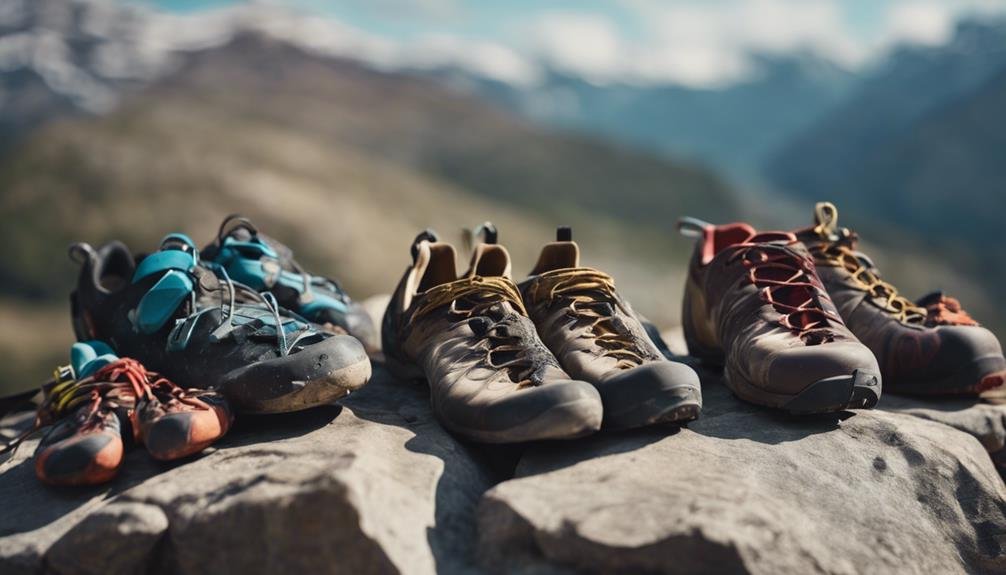
When I choose climbing shoes, I often start by understanding the various types available, as each is designed to meet specific climbing needs and styles. Climbing shoe characteristics play a crucial role in performance, and I pay close attention to the fit, stiffness, and rubber quality.
For example, aggressive shoes feature a downward-pointing toe, which enhances precision on small footholds but may compromise comfort over long routes. Moderate shoes strike a balance, offering a comfortable fit without sacrificing performance, making them ideal for multi-pitch climbs. Then there are neutral shoes, perfect for beginners or those who prioritize comfort during extended wear.
The sole construction design also varies significantly among shoe types. Stiffer soles provide better support and power transfer, while softer soles allow for greater sensitivity and flexibility, letting me feel the rock beneath my feet. The rubber compound used on the sole affects grip and durability, so I consider my climbing environment and style.
Ultimately, understanding these types and their characteristics empowers me to make informed choices, ensuring I've the freedom to tackle any climbing challenge with confidence.
Importance of Proper Fit
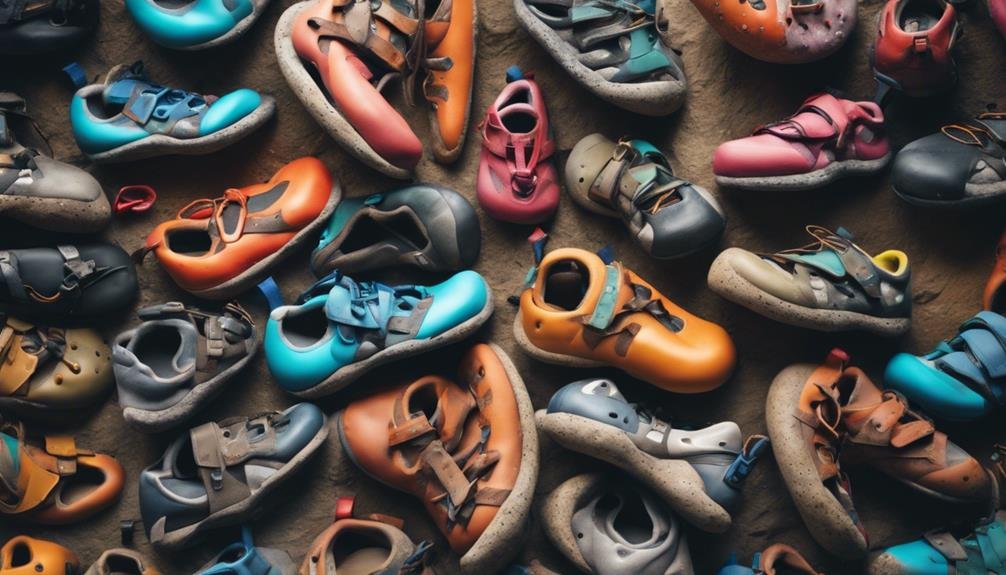
When I choose climbing shoes, I can't underestimate the importance of proper fit. A well-fitted shoe enhances performance by providing better precision and control on the rock, while also reducing the risk of injuries like blisters or tendon strains.
Getting the right fit isn't just about comfort; it's crucial for achieving my climbing goals safely and effectively.
Enhanced Performance Benefits
A proper fit in climbing shoes not only enhances my performance on the rock but also significantly reduces the risk of injury, allowing me to focus on technique rather than discomfort. When my shoes fit correctly, I experience increased stability, which is crucial for maintaining balance on challenging routes. This stability comes from the shoe's snugness, enabling me to feel confident in my foot placements.
Moreover, the right fit contributes to enhanced friction between my shoe and the climbing surface. This heightened sensitivity allows me to make more precise movements, maximizing my grip on various rock types. I can trust that every foot placement counts, whether I'm edging on a tiny foothold or smearing on a slab.
Furthermore, a well-fitted shoe helps in distributing pressure evenly across my foot, which aids in reducing fatigue during long climbs. I can push my limits, knowing my gear is working with me, not against me.
Ultimately, investing time in finding the perfect fit translates to improved performance and a more enjoyable climbing experience, letting me fully embrace the freedom of movement that climbing offers.
Injury Prevention Strategies
Properly fitting climbing shoes are essential for preventing injuries, as they not only support my foot structure but also promote optimal movement and reduce the risk of strain during climbs. A well-fitted shoe ensures proper foot stability, which is crucial when navigating tricky routes. The heel counter fit, in particular, plays a vital role; it locks my heel in place, minimizing any unnecessary movement that could lead to blisters or worse, injuries.
When I think about injury prevention, I often reflect on:
- The freedom to climb without the fear of slipping or falling
- The joy of pushing my limits, knowing my feet are secure
Finding the right fit is more than just comfort; it's about empowering myself to explore new heights. I can't stress enough how crucial it's to try different models and pay attention to how they hug my foot. Ensuring that my climbing shoes provide excellent foot stability and an appropriate heel counter fit can make all the difference in my climbing experience.
Sizing Guidelines

Finding the right size in climbing shoes can make or break your performance, so it's crucial to get it right from the start. When I first began climbing, I underestimated how important sizing was. I quickly learned that a snug fit provides the arch support I need for precision on small footholds. Ideally, your toes should lightly touch the front of the shoe, but they shouldn't be painfully crammed.
I also pay attention to shock absorption. A good climbing shoe should let me feel the rock while still offering enough cushioning to protect my feet during dynamic movements. I've found that trying on different brands and styles helps me identify which shoes balance support and comfort best for my foot shape.
Don't be afraid to size down a bit, but always remember that your comfort level is key. I generally opt for a fit that's snug but allows me to wiggle my toes slightly. Ultimately, I recommend checking the manufacturer's size chart, as sizes can vary widely. A well-fitted shoe can empower my climbing experience, enhancing both my performance and enjoyment on the wall.
Shoe Shape Considerations
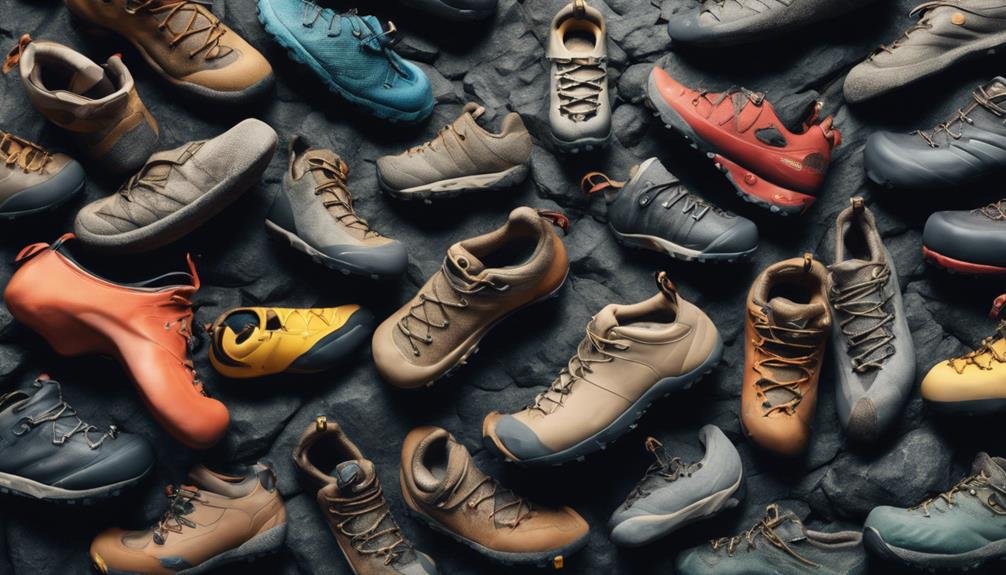
After nailing down the right size, considering the shoe shape becomes vital for optimizing my climbing performance. The shape of my climbing shoes directly affects my foot's position, stability, and overall comfort on the rock. I pay particular attention to the toe box shape and heel cup construction, as these elements can make or break my climbing experience.
A snug toe box allows for precision on tiny footholds. A well-designed heel cup locks my foot in place, providing confidence on overhangs. The right shape enhances my connection to the rock, giving me the freedom to push my limits.
When selecting a shoe, I consider whether I need a pointed toe for technical climbs or a rounded toe box for comfort during long days on the wall. The heel cup construction should feel secure without pinching, allowing me to focus on my movements rather than my feet. Ultimately, the right shoe shape aligns with my climbing style, ensuring I can embrace the freedom of the climb while maintaining optimal performance. Balancing these factors empowers me to conquer new challenges and reach new heights.
Material Options
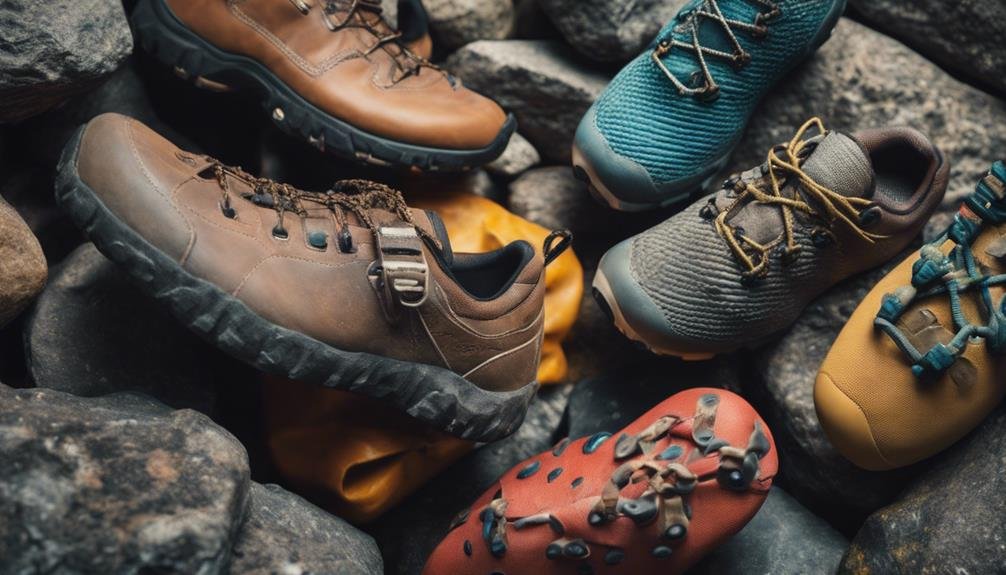
The choice of materials in climbing shoes significantly impacts performance, durability, and comfort on the rock. I've found that the two most common materials are leather and synthetic composites.
Leather offers excellent durability, molding to your foot over time, but it can stretch and may require a break-in period. On the other hand, synthetic materials tend to be stiffer, providing immediate performance but may lack some of that "custom fit" feel.
When I consider material comfort, I always keep in mind breathability. Shoes made from breathable synthetics can help keep my feet cool and reduce moisture buildup during long climbs. This aspect is vital, as discomfort can detract from my focus and performance.
Additionally, I pay attention to the shoe's lining. A good lining not only enhances comfort but also contributes to the shoe's overall durability. Some brands use moisture-wicking fabrics that keep my feet dry and comfortable, while others might prioritize toughness.
Ultimately, balancing material durability and material comfort is key for me. The right choice can mean the difference between a successful ascent and a frustrating retreat. So, I always evaluate my specific needs before making a decision.
Closure Mechanisms

When selecting climbing shoes, I pay close attention to closure mechanisms, as they directly influence fit and adjustability during climbs. The right closure design can make or break my climbing experience, impacting not only comfort but also performance on the wall. I typically consider three primary types of closures: Velcro straps, laces, and slip-ons.
Velcro straps allow for quick adjustments, perfect for multi-pitch climbs where I need to switch shoes rapidly.
Laces provide fine-tuned closure adjustability, enabling me to customize fit around my foot's contours for maximum sensitivity.
Slip-ons offer a snug, sock-like feel, minimizing bulk and enhancing freedom of movement.
Each closure mechanism has its advantages and disadvantages, so I weigh my climbing style and the routes I tackle when making a choice. I've found that the right combination of closure design and adjustability can lead to better foot placement and confidence on the rock. Ultimately, my goal is to feel secure and liberated, allowing me to focus on the climb ahead without worrying about my shoes.
Stiffness and Flexibility

When I choose climbing shoes, stiffness and flexibility are crucial factors that shape my performance.
Stiff shoes offer excellent support and precision on small footholds, while flexible options allow for better sensitivity and movement on varied terrain.
Understanding how each characteristic affects my climbing style helps me make the right choice for my needs.
Importance of Stiffness
Stiffness plays a crucial role in how well climbing shoes perform on various surfaces, directly influencing precision and power transfer during ascents. When I'm scaling a challenging route, having the right stiffness not only enhances my climbing technique but also provides the necessary arch support to keep my feet comfortable and secure. A stiffer shoe allows me to focus on foot placements, maximizing my grip on small footholds.
It transforms every foot movement into a powerful push.
It gives me the confidence to tackle overhangs and technical sections.
It ensures my feet feel supported, reducing fatigue on long climbs.
Choosing the right level of stiffness is essential for my climbing style. A shoe that's too soft can lead to poor foot positioning and wasted energy, while one that's too stiff might hinder my ability to feel the rock beneath me. Balancing stiffness with comfort is key.
I've learned through experience that a well-fitted, stiff shoe can elevate my performance, allowing me to climb with freedom and precision. Always remember, the right stiffness can make or break your climbing experience!
Benefits of Flexibility
Flexibility in climbing shoes offers several advantages that enhance my ability to navigate varied terrains and make precise foot placements. When I opt for a more flexible shoe, I experience improved foot dexterity, allowing me to feel every nuance of the rock beneath me. This tactile connection is crucial for executing delicate moves on small footholds or slippery surfaces.
Moreover, flexible shoes provide enhanced support around my foot, ensuring that I can maintain comfort during long climbs without sacrificing performance. They adapt to the natural shape of my foot, which is particularly beneficial during technical climbs that require intricate footwork. I find that a softer shoe allows my foot to engage better with the rock, promoting greater confidence in my movements.
While stiffness is essential for certain climbing scenarios, flexibility has its place in my arsenal. It empowers me to push my limits and explore routes that demand finesse rather than brute strength. Ultimately, choosing the right balance between flexibility and stiffness in my climbing shoes enhances my overall climbing experience, enabling me to embrace the freedom of movement that every climber craves.
Terrain-Specific Features

Choosing the right climbing shoes hinges on understanding the specific terrain you'll be tackling, as each type demands unique features for optimal performance. Whether I'm scaling a granite face, tackling slippery sport routes, or navigating rugged boulders, I know that the right shoe can enhance my experience and safety.
For example, when I'm on rocky surfaces, grip quality becomes paramount. I look for shoes with a rubber compound that provides excellent friction. Conversely, for wet or mossy areas, I prioritize traction requirements—shoes with deeper lugs can make all the difference.
Different styles, like sport or trad, require varying levels of precision and support.
The nature of the rock can dictate the shoe's design, including its sole thickness and rubber composition.
Rain or humidity can affect grip and stability, so I choose shoes that adapt to these elements.
Ultimately, understanding these terrain-specific features not only elevates my climbing experience but also fuels my passion for exploration.
Trying Before Buying

When I'm choosing climbing shoes, I always prioritize an on-site fitting experience to ensure the best fit.
Each shoe type offers unique features that cater to different climbing styles, so trying them on is essential.
This hands-on approach helps me feel the nuances in performance and comfort before making a decision.
On-Site Fitting Experience
Trying on climbing shoes in-store allows me to assess the fit and comfort level crucial for my performance on the rock. Nothing compares to the immediate feedback I get from the actual feel of the shoe. With personalized sizing, I can explore how different brands and models hug my foot, ensuring I find that optimal fit that makes all the difference.
The thrill of feeling every foothold connect
The confidence that comes from a secure fit
The freedom to tackle challenging routes without hesitation
During the fitting process, I pay attention to how the shoe wraps around my foot, the sensitivity it provides, and how it aligns with my climbing style. A snug fit is essential, but I also need to ensure circulation isn't compromised. I often try on multiple sizes, adjusting the laces to find the perfect balance between tightness and comfort.
Different Shoe Types
Different climbing shoe types cater to various styles and terrains, so understanding each option helps me make an informed choice when trying them on. First, there's the aggressive shoe, designed for sport climbing and bouldering. Its downward camber and pointed toe enhance precision on small footholds, aligning perfectly with my need for performance.
Then, I consider moderate shoes, which balance comfort and performance—ideal for multi-pitch climbs where I want both support and agility.
Lastly, I can't overlook the relaxed shoe, perfect for beginners or long days on the rock. It provides maximum comfort, allowing me to focus on my technique rather than foot fatigue. Each type has its own specialty features, like rubber thickness and closure systems, which can significantly impact my climbing experience.
When I try on different climbing shoes, I keep my specific climbing goals in mind. Am I looking for precision in challenging routes, or do I need comfort for a long day? By evaluating the shoe specialty features against my goals, I can find the perfect fit that supports my journey up the wall.
Maintenance and Care Tips
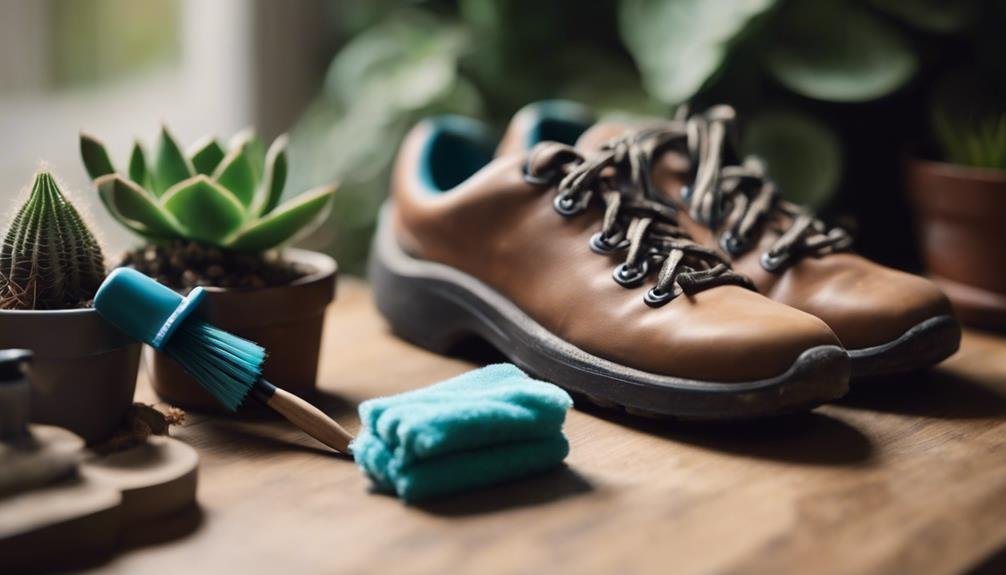
To keep your climbing shoes in top condition, I recommend regularly cleaning them and storing them properly after each use. This not only extends their lifespan but also ensures optimal performance on the rock. I've learned that neglecting maintenance can lead to premature shoe replacement, so I make it a habit to check my shoes frequently.
- Clean regularly: Wipe off dirt and sweat after each climb to prevent material degradation.
- Air dry: After cleaning, let them dry naturally away from direct heat sources to avoid damaging the rubber and leather.
When it comes to shoe replacement frequency, I usually assess my shoes every few months, depending on how often I climb. If I notice reduced grip or discomfort, it's time for new ones. By paying attention to storage considerations and maintenance, I can savor the freedom of climbing without the worry of equipment failure.
Conclusion
As I stepped into the climbing shop, the scent of rubber and chalk filled the air, and I felt a thrill of anticipation.
Each shoe I tried on whispered promises of performance and comfort. Would I find the perfect fit that would elevate my climbs?
I knew that with the right choice, every ascent could become a dance with gravity.
So, I took a deep breath, ready to embrace the challenge of finding my ideal climbing shoes.
